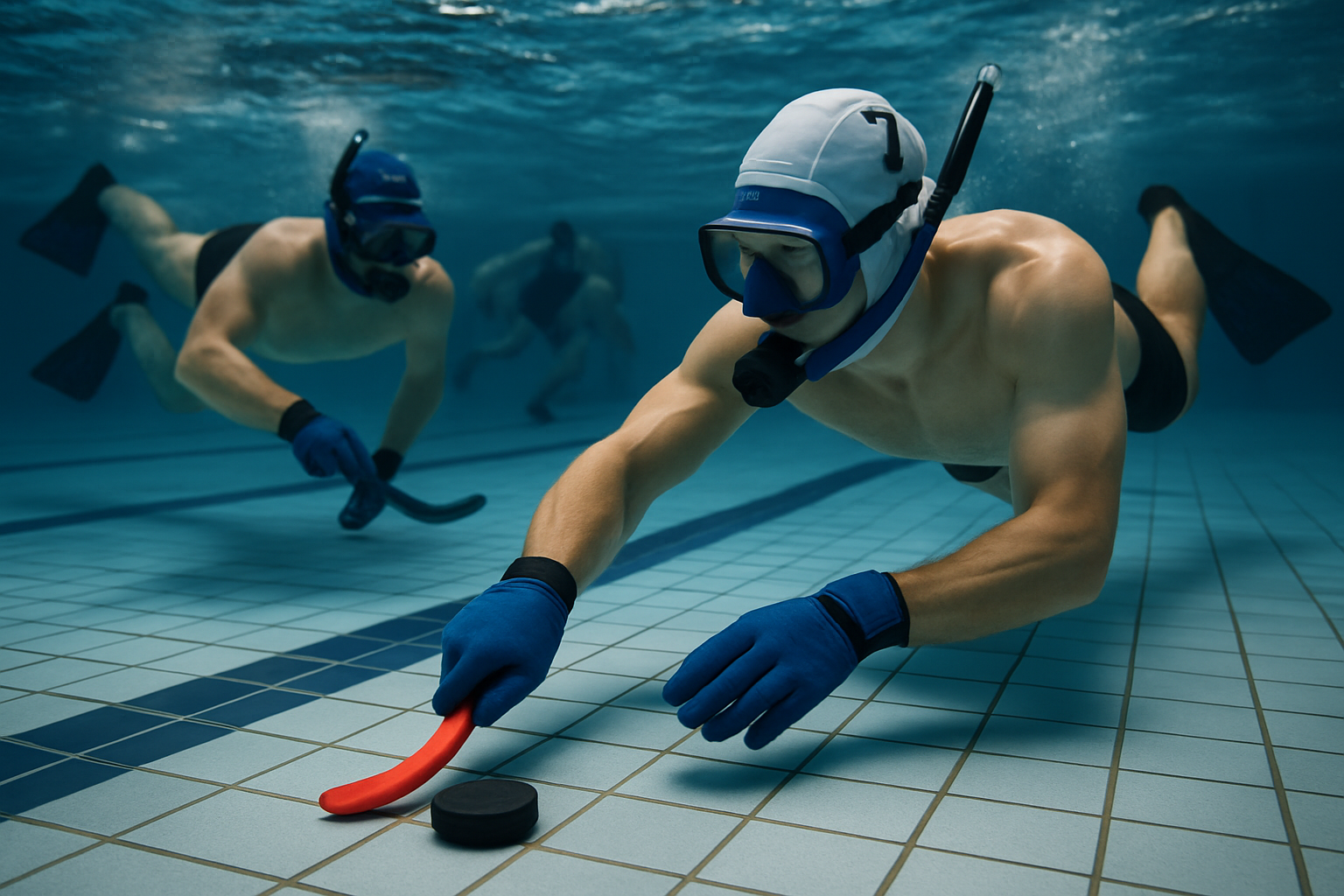Underwater Hockey: The Submerged Sport Taking the World by Storm
Imagine a sport that combines the strategy of ice hockey, the agility of water polo, and the endurance of freediving. Welcome to the thrilling world of underwater hockey, a unique aquatic discipline that's captivating athletes and spectators alike. This submerged sport challenges players to push their physical and mental limits, all while holding their breath and maneuvering in three dimensions.

The early days of underwater hockey were characterized by improvised equipment and rudimentary rules. Players used lead pucks and wooden sticks, often fashioning their gear from whatever materials were available. As the sport gained popularity, specialized equipment was developed, including curved composite sticks, rubber-coated lead pucks, and protective gloves designed for underwater use.
The Mechanics of Play
At its core, underwater hockey is a team sport played on the bottom of a swimming pool. Two teams of six players each compete to maneuver a puck across the pool floor and into the opposing team’s goal. The playing area is typically 25 meters long and 15 meters wide, with goals at each end measuring 3 meters wide.
Players wear masks, snorkels, and fins, along with protective headgear, gloves, and mouth guards. They use short sticks, about 30 centimeters long, to push, flick, and maneuver the puck. The game is played in four quarters, each lasting 8 minutes, with a 3-minute break between quarters.
One of the most challenging aspects of underwater hockey is the need for players to hold their breath while competing. This requires not only exceptional lung capacity but also strategic thinking and efficient movement underwater. Players must surface regularly to breathe, making teamwork and rotation crucial for maintaining possession and scoring opportunities.
Physical and Mental Demands
Underwater hockey is an incredibly demanding sport that requires a unique combination of physical attributes and mental fortitude. Players must possess excellent cardiovascular fitness, muscular endurance, and breath-holding capacity. The sport also demands agility, spatial awareness, and the ability to think and react quickly in a three-dimensional environment.
Training for underwater hockey involves a mix of pool sessions, dry-land exercises, and breath-holding techniques. Players often incorporate freediving exercises to improve their lung capacity and comfort underwater. Strength training focuses on core stability, leg power for propulsion, and upper body strength for maneuvering the puck.
The mental aspect of underwater hockey is equally challenging. Players must remain calm and focused while operating in an environment where communication is limited. They must also manage the psychological stress of breath-holding and make split-second decisions under pressure.
Global Growth and Competition
Since its inception, underwater hockey has grown into a globally recognized sport with national federations in over 20 countries. The sport made its debut at the World Games in 1981 and has been featured in multiple editions since then. The Confederation Mondiale des Activites Subaquatiques (CMAS) oversees international competitions, including the World Championships held every two years.
Australia and New Zealand have historically dominated the sport, but countries like Colombia, France, and South Africa have emerged as strong competitors in recent years. The United States and Canada have also seen significant growth in participation and success at international tournaments.
One of the most exciting developments in underwater hockey has been the rise of youth programs and collegiate leagues. Many countries now have junior national teams and school-based competitions, ensuring a steady pipeline of talent for the sport’s future.
Technological Advancements and Equipment Evolution
As underwater hockey has grown, so too has the technology and equipment used in the sport. Modern players benefit from advanced materials and designs that enhance performance and safety. Masks now feature wider fields of vision and improved hydrodynamics, while fins are engineered for optimal propulsion and maneuverability.
The pucks used in competitive play are made of lead covered with a protective plastic coating, designed to glide smoothly along the pool bottom. Sticks have evolved from simple wooden designs to sophisticated composites that offer improved control and durability.
Perhaps the most significant technological advancement has been in underwater cameras and live-streaming capabilities. These innovations have made it possible to broadcast underwater hockey matches to a wider audience, increasing the sport’s visibility and appeal.
Physiological Benefits and Research
The unique nature of underwater hockey has attracted the attention of sports scientists and physiologists. Research has shown that the sport offers numerous health benefits, including improved cardiovascular fitness, increased lung capacity, and enhanced overall body strength and flexibility.
Studies have also explored the potential cognitive benefits of underwater hockey. The combination of physical exertion, breath control, and strategic thinking is believed to promote neuroplasticity and improve cognitive function. Some researchers have even suggested that the sport could have therapeutic applications for individuals with respiratory conditions or anxiety disorders.
Challenges and Future Prospects
Despite its growth, underwater hockey faces several challenges as it seeks to expand its global footprint. One of the primary obstacles is the need for specialized facilities. While the sport can be played in standard swimming pools, dedicated underwater hockey venues with specific features like non-slip pool bottoms and underwater lighting are ideal for competitive play.
Another challenge is increasing public awareness and media coverage. The submerged nature of the sport can make it difficult for spectators to follow the action, although advancements in underwater filming technology are helping to address this issue.
Looking to the future, underwater hockey enthusiasts are working to gain recognition from the International Olympic Committee. While inclusion in the Olympic program remains a long-term goal, the sport’s governing bodies are focusing on increasing participation at grassroots levels and expanding into new markets.
Environmental Considerations and Sustainability
As an aquatic sport, underwater hockey has a unique relationship with the environment. Many players and organizations within the sport have become advocates for ocean conservation and water quality awareness. Some underwater hockey clubs organize beach and river clean-ups, while others partner with marine conservation groups to raise awareness about aquatic ecosystems.
The sport’s equipment manufacturers are also embracing sustainability, developing eco-friendly alternatives to traditional materials. Some companies are experimenting with biodegradable plastics for stick handles and recycled materials for fins and protective gear.
Cultural Impact and Community Building
Beyond its physical and competitive aspects, underwater hockey has fostered a strong sense of community among its participants. The sport’s unique nature tends to attract individuals who are adventurous and open-minded, leading to a diverse and inclusive community of players.
Many underwater hockey clubs organize social events, training camps, and international exchanges, fostering friendships and cultural understanding across borders. The sport has become particularly popular in coastal communities and islands, where it serves as a bridge between traditional water sports and team athletics.
Adaptations for Different Age Groups and Abilities
One of the strengths of underwater hockey is its adaptability to different age groups and skill levels. Modified versions of the sport have been developed for children, seniors, and individuals with disabilities. For younger players, shallow-water variants allow for easier breathing and simplified rules, while still developing the core skills needed for the full version of the sport.
Adaptive underwater hockey programs have been created for players with physical disabilities, including modified equipment and rule sets. These initiatives have opened up the sport to a broader range of participants and highlighted its potential for rehabilitation and therapy.
The Role of Coaching and Skill Development
As underwater hockey continues to evolve, coaching methodologies and skill development programs have become increasingly sophisticated. Coaches focus on developing players’ underwater awareness, stick skills, and tactical understanding of the game. Advanced training techniques include underwater obstacle courses, breath-holding exercises, and video analysis of game footage.
Many countries have established coaching certification programs to ensure high standards of instruction and player development. These programs cover not only the technical aspects of the sport but also safety protocols, sports psychology, and team management.
Nutritional Considerations for Underwater Athletes
The unique demands of underwater hockey require specific nutritional strategies. Players need to balance energy intake for sustained underwater activity with the need to maintain neutral buoyancy. Diets rich in lean proteins, complex carbohydrates, and healthy fats are typically recommended to support performance and recovery.
Hydration is also a critical factor, as even mild dehydration can significantly impact breath-holding capacity and overall performance. Some players experiment with specific pre-game nutrition plans to optimize their energy levels and reduce the risk of cramping underwater.
The Psychology of Underwater Competition
Competing in an underwater environment presents unique psychological challenges. Players must manage the stress of breath-holding while maintaining focus on the game. Mental training techniques, including visualization and mindfulness practices, have become an integral part of many players’ preparation.
Sports psychologists working with underwater hockey teams often focus on developing mental resilience, improving communication skills in a non-verbal environment, and managing the anxiety that can come with prolonged submersion.
International Tournaments and Championships
The pinnacle of underwater hockey competition is the CMAS Underwater Hockey World Championship, held every two years. This event brings together the best teams from around the world, showcasing the highest level of skill and strategy in the sport.
In addition to the World Championship, there are numerous regional and continental tournaments. The European Championship, Pan American Championship, and Oceania Championship are all highly competitive events that serve as qualifiers for the World Championship.
These international tournaments not only provide a platform for elite competition but also serve as important networking events for the global underwater hockey community. Players, coaches, and officials use these gatherings to exchange ideas, discuss rule changes, and plan for the sport’s future development.
Gender Equality and Mixed Competition
Underwater hockey has been at the forefront of gender equality in sports, with mixed-gender teams being common at many levels of play. The physical nature of the sport underwater tends to level the playing field between men and women, making skill, strategy, and teamwork the primary factors in success.
Many international tournaments feature both single-gender and mixed-gender categories, providing opportunities for players of all genders to compete at the highest level. This inclusive approach has been credited with driving growth in participation, particularly among female athletes.
The Intersection of Science and Sport
The unique nature of underwater hockey has made it an interesting subject for scientific research. Physiologists study the cardiovascular and respiratory adaptations of elite players, while biomechanists analyze the mechanics of underwater movement and puck control.
Some researchers are exploring the potential applications of underwater hockey training techniques in other fields, such as military and rescue diving. The sport’s emphasis on efficient underwater movement and breath control has valuable applications beyond competitive play.
Educational Programs and Youth Development
Recognizing the importance of nurturing young talent, many countries have implemented underwater hockey programs in schools and universities. These programs not only introduce students to the sport but also teach valuable life skills such as teamwork, perseverance, and water safety.
Some educational institutions have even integrated underwater hockey into their physical education curricula, recognizing its unique benefits for overall fitness and aquatic skills development. These initiatives are crucial for ensuring the long-term growth and sustainability of the sport.
The Role of Technology in Training and Performance Analysis
As in many sports, technology is playing an increasingly important role in underwater hockey training and performance analysis. Wearable devices that can function underwater are being used to track players’ movements, heart rates, and oxygen levels during games and training sessions.
Virtual reality simulations are being developed to help players improve their spatial awareness and decision-making skills without the need for pool time. These technologies are particularly valuable for teams in regions where access to suitable training facilities is limited.
Conclusion: The Future of Underwater Hockey
As underwater hockey continues to grow and evolve, it stands as a testament to human ingenuity and the endless possibilities for sporting innovation. The sport combines physical prowess, strategic thinking, and teamwork in a unique aquatic environment, challenging athletes in ways that few other disciplines can match.
With its growing global popularity, advancements in equipment and training techniques, and increasing recognition from the broader sporting community, underwater hockey is poised for a bright future. As more people discover the thrill of this submerged sport, it’s likely that we’ll see continued growth in participation, competitive opportunities, and public interest.
The journey of underwater hockey from a niche training exercise to a globally recognized sport illustrates the power of passion and community in driving athletic innovation. As the sport moves forward, it will undoubtedly continue to push the boundaries of human performance underwater, inspiring athletes and spectators alike with its unique blend of skill, strategy, and aquatic artistry.





